Authentic Thai cookery course
Most people want to learn to cook the popular Thai dishes listed below, but you're the boss—I can easily tailor the course if there's a dish you've eaten somewhere that you want to learn.
Each lesson is themed and takes about 90 minutes, and generally you should choose two of the dishes to make. (Although some people choose to make all the curries or all the Party Specials over two lessons instead of one—again, you're the boss.)
There's a discount for booking the whole course. Contact me for the full Thai cookery course prices.
-
Introduction to Thai cooking
Your first lesson will introduce you to the flavours of Thai cooking and its essential ingredients. You'll learn how to cook rice properly, and to get started, you'll learn how to cook a popular mild Thai dish, chicken with cashew nuts (pictured) and pad pak ruammit (stir-fried mixed vegetables).
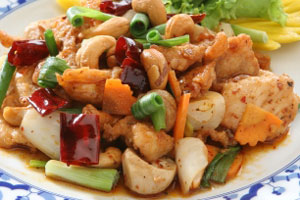
-
Soup
We Thais love soups. They aren't reserved as starters, but come with the other main course dishes, and are spooned over rice and eaten. You'll learn the sour, lemony soup tom yam and the rich, coconut-based tom kha (pictured below), using fish, seafood or the meat of your choosing.
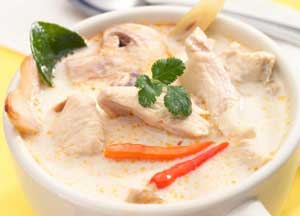
-
Curry
Thai curries are very different from Indian curries. There's green curry, with its spicy sauce and peppery baby eggplants. There's coconut-based red curry (below) which is excellent with duck or pork. There's geng ga-rii gai, a mild yellow curry, rich paneng curry, and mussaman curry, which was originally cooked by Thailand's muslims using that exotic vegetable, the potato (well, it's exotic for Thailand!).
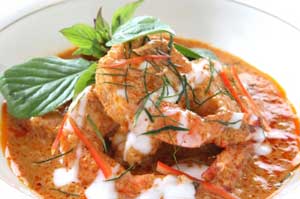
-
Salads
Thai salads are nothing like European ones; the term generally refers simply to dishes whose only cooked ingredients is the meat or seafood. Generally, a significant part of the salad is chilli, so you can expect them to be pretty spicy.
You'll learn spicy beef or squid salad (pictured below), or the somtam, the legendarily spicy raw papaya salad from Isaan, the North-east of Thailand (subject to the availability of the ingredients, and your bravery).
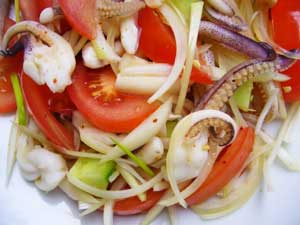
-
Stir fries and one-plate meals
These are the quick and nutritious meals that you grab for a snack or a lunchtime meal on the go. They're common in cafés near offices and schools. Sample dishes are beef in oyster sauce, pad krapow (meat and vegetables stir-fried with Holy basil - pictured below), egg-fried rice and gai pad khing (chicken fried with ginger).
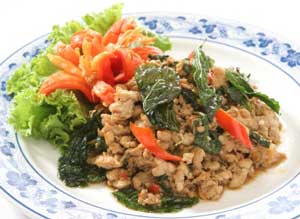
-
Noodles
This dish, originally from China, has been adopted and adapted by Thais as a delicious fast food. There are hundreds of different noodle dishes, so we suggest our favourites:
- pad see euw: wide noodles, fried with vegetables, egg and meat
- duck noodles: egg noodles in duck soup
- pad kee mao ("drunk noodles"): fried wide noodles, with a chilli kick
- pad thai: everyone's favourite: stir-fried rice noodles with eggs, fish sauce, tamarind juice, red chilli pepper, plus any combination of bean sprouts, shrimp, chicken, or tofu, garnished with crushed peanuts and coriander (pictured)
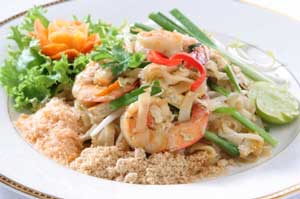
-
Party Specials
These are dishes that take a little extra preparation, so they look as great as they taste. We cook them to wow guests at dinner parties—you'll want to do the same.
- plaa manow: a whole fish cooked under a mound of lime, garlic and chilli. It looks spectacular on the plate and is tasty but surprisingly not very spicy. The very nicest (but expensive) way to prepare this dish is to use monkfish; the thick flesh aborbs the flavours absolutely perfectly.
- kao ob sapparot: rice cooked and served in a hollowed-out pineapple
- spring rolls: you know what these are!
- gai hor bai teuy: bite-sized pieces of boneless chicken cooked in parcels of pandamas leaves (pictured)
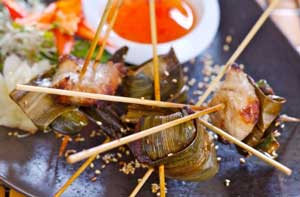
The Thai regional cookery course
There's an advanced course, too, which can be taken as a follow-up to the usual course. I teach those foods which are common in Thailand but are very rare in British "Thai" restaurants, such as "khao soi" which we eat in North Thailand, and delicacies from Isaan (the area on the Thai-Laos border) like namtok moo, laab and gai yang. We don't do cow placenta soup, though.